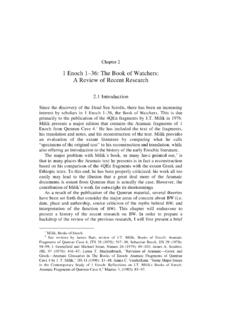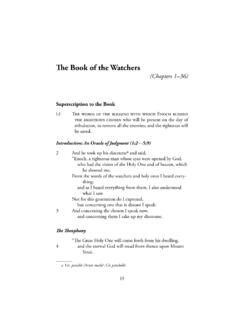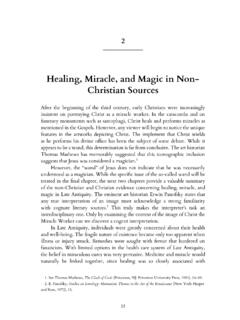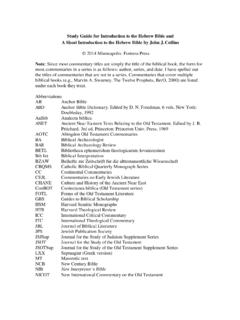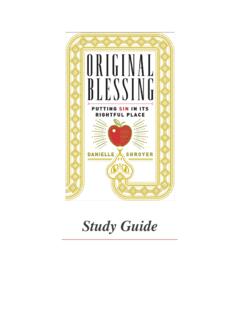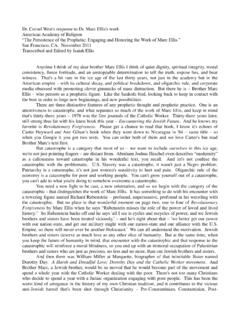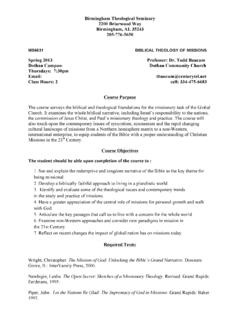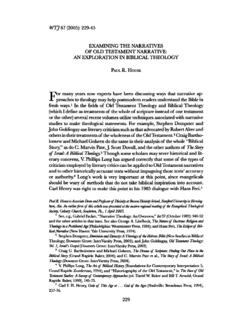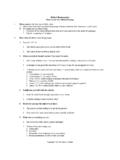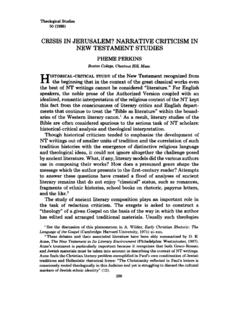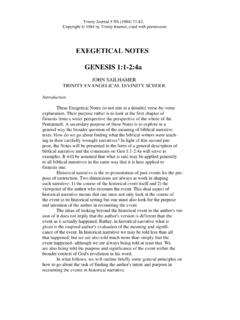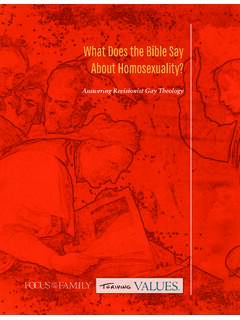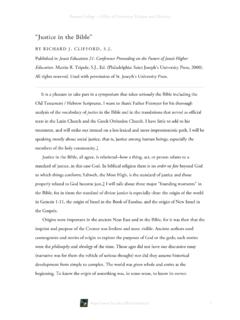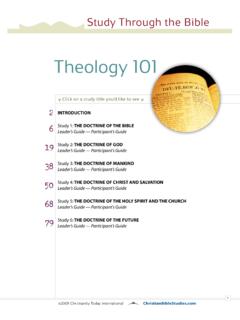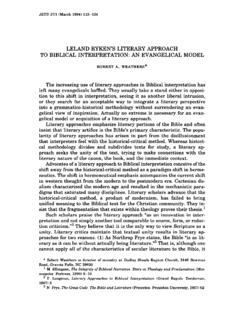Transcription of A Theory of Character in New Testament Narrative
1 1 IntroductionIdentifying a Dominant ,movie, , ,forexample,explicitlystatesthatthepurpo seforhiswritingisthathisaudiencemaycomea ndcontinuetobelievethatJesusistheMessiah ,theSonofGod,inordertopartakeinthedivine life(John20:30-31).Inordertoaccomplishth ispurposeJohndeliberatelyputsonthestagev ariouscharactersthatinteractwithJesus, ,andinsodoingrecommendsomecharacterstobe emulatedandotherstobeavoided,is an important reason to study same holds true for the Bible as a whole . While the Bible, at one level, is an anthology ofindividual stories, it arguably also contains the grand story of God s dealings with humanity and theworld, with the purpose that people recognize God s desire to have a relationship with them and respondto him.
2 Thus, analyzing the characters in the individual stories in the Bible also assists in understandingthe protagonist of the meta-story and his program for this world. While postmodernists are critical of(even deny) metanarratives, others provide a good case for the Bible telling a single story with a singleand integrated meaning (Kevin J. Vanhoozer,Is There a Meaning in This Text?: The Bible, the Reader, andthe Morality of Literary Knowledge[Grand Rapids: Zondervan, 1998]; Richard Bauckham,Bible andMission: Christian Witness in a Postmodern World[Grand Rapids: Baker Academic, 2003], ch. 4). plot, , Itisremarkablehowlittlehasbeensaidaboutt hetheoryofcharacterinliteraryhistoryandc riticism.
3 3 Similarly,ShlomithRimmon-Kenanremarks, Theelaborationofasystematic,non-reductiv ebutalsonon-impressionistictheoryofchara cterremainsoneofthechallengespoeticshasn otyetmet. 4 Withfewexceptions,literarycriticismhasno tadvancedbeyondthewell-knowncategoriesof flat and round , (charactersresemblepeoplebutarenotreal)a ndthedifficultyofanalyzingcharacter (something one can rarely read from the surface of the text).6 Theseobservationsalso(orespecially)holdt ruefornarrativecriticism, , ,whenappliedparticularlytotheGospels, , ,forexample,pointsoutthat [r]ecentworkonnarrativecriticismoftheGos pelshasemphasizedplotandstory, 7 FrancoisTolmiecommentsthatthelackofaunif ormapproachtocharacterizationinbiblicaln arrativesisunderstandablebecause contemporaryliterarycriticismhasnotyetpr ovidedasystematicandcomprehensivetheoryf ortheanalysisofcharacter.
4 Chatman,Story and Discourse: Narrative Structure in Fiction and Film(Ithaca, NY/London:Cornell University Press, 1978), 19; Shlomith Rimmon-Kenan, Narrative Fiction: Contemporary Poetics,2nd ed. (London/New York: Routledge, 2002 [1983]), 3, ,Story and Discourse, , Narrative Fiction, modern writers have even pronounced the death of Character (see Rimmon-Kenan,NarrativeFiction, 29 31). For them there is obviously no incentive to develop a Theory of Mieke Bal,Narratology: Introduction to the Theory of Narrative , trans. C. van Boheemen (Toronto:University of Toronto Press, 1985), , Characterization, Francois Tolmie,Jesus Farewell to the Disciples: John 13:1 17:26 in Narratological Perspective(BIS12; Leiden: Brill, 1995), 117 18 (quotation from p.)
5 118).2|A Theory of Character in New Testament NarrativeElizabethStruthersMalbonobserve sthat [w]aysofanalyzingcharacterizationintheGo spelsarestillbeingdeveloped but [m]oreresearchremainstobedoneinthisarea. 9 Attheoutsetofhismonograph,KellyIversonpo intsoutthat atheoryofcharacterisacomplexandbynomeans settledissueamongliterarycritics. 10 Morerecently,NicolasFarellyremarksthatas [c] [i]tisallthemoresurprisingthatthisareaof narrativeanalysishasnotproducedalargerar rayofstudiesontheFourthGospel scharacters. 11 Asrecentlyas2013,twoverydifferentvolumes onJohanninecharacterizationappeared:onev olumecontainssevenessaysonthetheoryofcha racterstudy,witheachofthemstressingdiffe rentaspects;12theothervolumeanalyzesseve ntyJohanninecharacterswherecontributorsa refreetochoosetheirownapproach, ,characterstudyisthusstillin its (wherecharacterscandevelop)toberadically differentfromthatinancientGreekliteratur e(wherecharactersaresupposedlyconsistent ethicaltypes).
6 Manyalsosharplydistinguishbetweenmodernf iction,withitspsychological,individualis ticapproachtocharacter, , ,asyet, Struthers Malbon,In the Company of Jesus: Characters in Mark s Gospel(Louisville:Westminster John Knox, 2000), 11 R. Iverson,Gentiles in the Gospel of Mark: Even the Dogs Under the Table Eat the Children sCrumbs (LNTS 339; London: T. & T. Clark, 2007), 1 n. Farelly,The Disciples in the Fourth Gospel: A Narrative Analysis of Their Faith andUnderstanding(WUNT II/290; T bingen: Mohr Siebeck, 2010), W. Skinner, ed.,Characters and Characterization in the Gospel of John(LNTS 461; NewYork: T. & T. Clark, 2013), 1 127. In fact, my essay in this volume is the only one aiming at acomprehensive approach to Character A.
7 Hunt, D. Francois Tolmie, and Ruben Zimmermann, eds., Character Studies in the FourthGospel: Narrative Approaches to Seventy Figures in John(WUNT 314; T bingen: Mohr Siebeck, 2013).The editors explain their decision for openness with respect to methodology on pp. xi my own 2009 work (for details, see Preface, n. 1), we can include Christopher W. Skinner,John and Thomas Gospels in Conflict? Johannine Characterization and the Thomas Question(PTMS 115;Eugene, OR: Wipf & Stock, 2009) (he focuses on misunderstanding); Susan E. Hylen,Imperfect Believers:Introduction|3theoryofcharacte rineitherliterarytheoryorbiblicalcritici sm, schallengefrom1992,that itisimportantto dosomethingabout thetheoreticalissuesinvolvedincharacteri zation,ratherthanjust talkingabout characters.
8 15 Thetaskofthisbook,then, ,wemustfamiliarizeourselveswiththecontri butions of scholars on the The Current State of AffairsTheearlieststudiesthatemployanarr ativeapproachtotheGospelsandActsarethose fromthe1980sbyDavidRhoadsandDonaldMichie (onMark),AlanCulpepper(onJohn),RobertTan nehill(onLuke Acts),andJackDeanKingsbury(onMatthew),an dexceptforTannehill, ,numerousstudiesoncharacterhaveappeared, butmanydonotuse,mention, ,Iwillnotsimplyrehearsethearrayofcharact erstudiesintheNewTestament, ,IhaveselectedtheGospelofMark,theAmbiguo us Characters in the Gospel of John(Louisville: Westminster John Knox, 2009) (she focuses onambiguity); S nke Finnern,Narratologie und biblische Exegese: Eine integrative Methode der Erz hlanalyseund ihr Ertrag am Beispiel von Matth us 28(WUNT II/285; T bingen: Mohr Siebeck, 2010), 125 64 (herelies on Jens Eder s work on Character in film); Alicia D.
9 Myers,Characterizing Jesus: A RhetoricalAnalysis on the Fourth Gospel s Use of Scripture in Its Presentation of Jesus(LNTS 458; New York: T. & , 2012) (she turns to ancient Greco-Roman characterization techniques); Skinner, ed.,Characters andCharacterization(various scholars focus on particular aspects of Character ). For the study of Character inliterary and media Theory , see Jens Eder, Fotis Jannidis, and Ralf Schneider, eds.,Characters in FictionalWorlds: Understanding Imaginary Beings in Literature, Film, and Other Media(Revisionen 3; Berlin/NewYork: De Gruyter, 2010). A. Darr,On Character Building: The Reader and the Rhetoric of Characterization in Luke Acts(Louisville: Westminster John Knox, 1992), Rhoads and Donald Michie,Mark as Story: An Introduction to the Narrative of a Gospel(Philadelphia: Fortress Press, 1982), chs.
10 5 6; R. Alan Culpepper,Anatomy of the Fourth Gospel: A Studyin Literary Design(Philadelphia: Fortress Press, 1983), ch. 5; Robert C. Tannehill,The Narrative Unity ofLuke Acts: A Literary Interpretation,2 vols. (Minneapolis: Fortress Press, 1986, 1989); Jack DeanKingsbury,Matthew as Story(Minneapolis: Augsburg Fortress Press, 1988), 9 27. Tannehill s work is anarratological commentary on Luke Acts and does not deal with the theoretical aspects of |A Theory of Character in New Testament NarrativeGospelofJohn, on the GOSPEL OF MARKM anyscholarshaveexaminedvariousMarkanchar acters, slandmarknarratologicalstudyonMark,Rober tTannehillandNormanPetersenhadalreadyadv ocatedreadingMark ,theyfocusonthenarrator sorimpliedauthor ,theauthorassumesthatthereareessentialsi milaritiesbetweenthecharactersinthenarra tiveworldandthereadersintherealworld,sot hatwhattheauthorrevealsaboutthecharacter smaybecomearevelation about the readers and so enable them to ,JoannaDewey.

